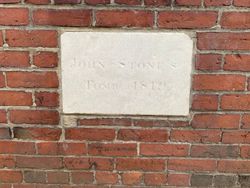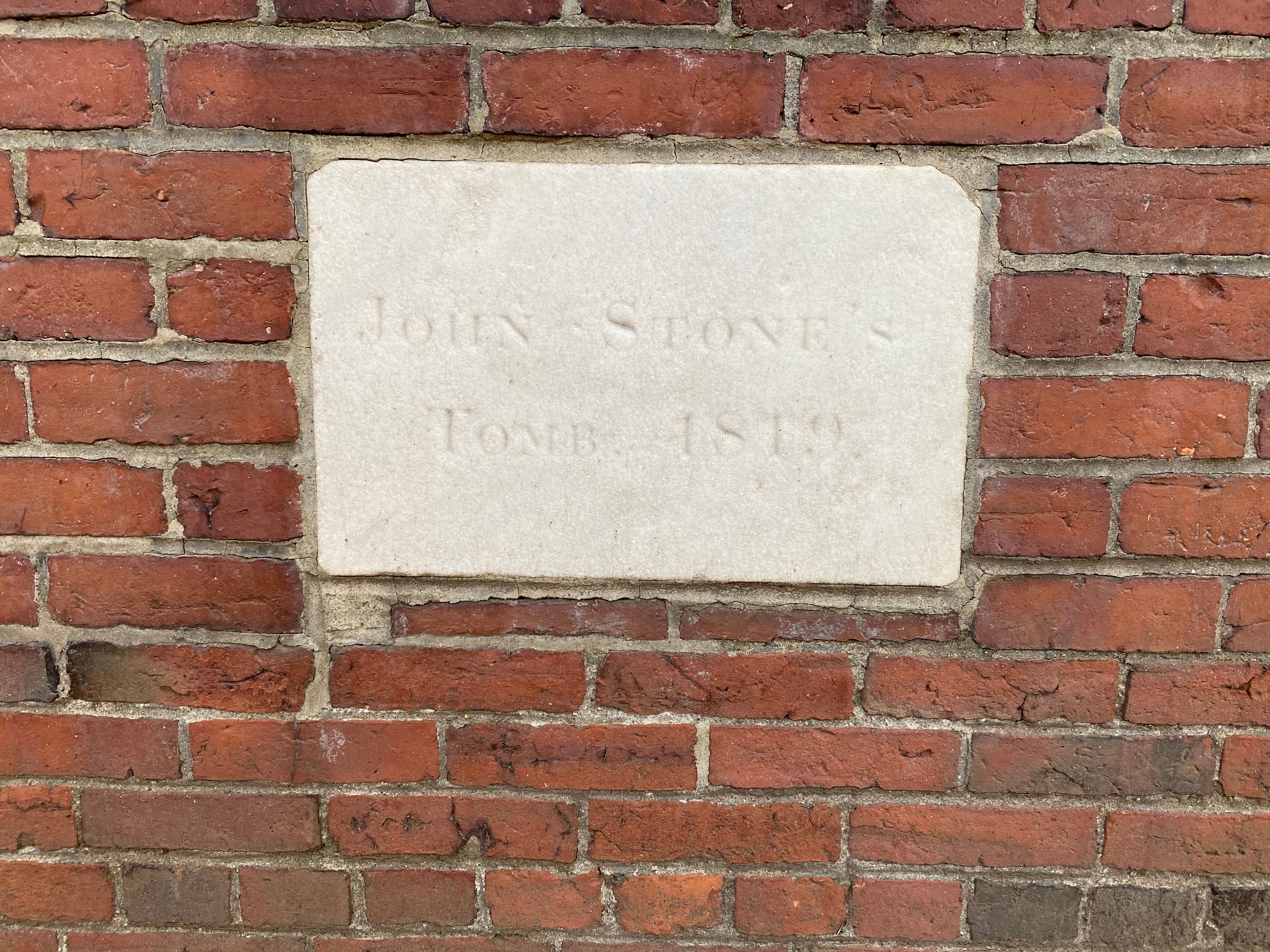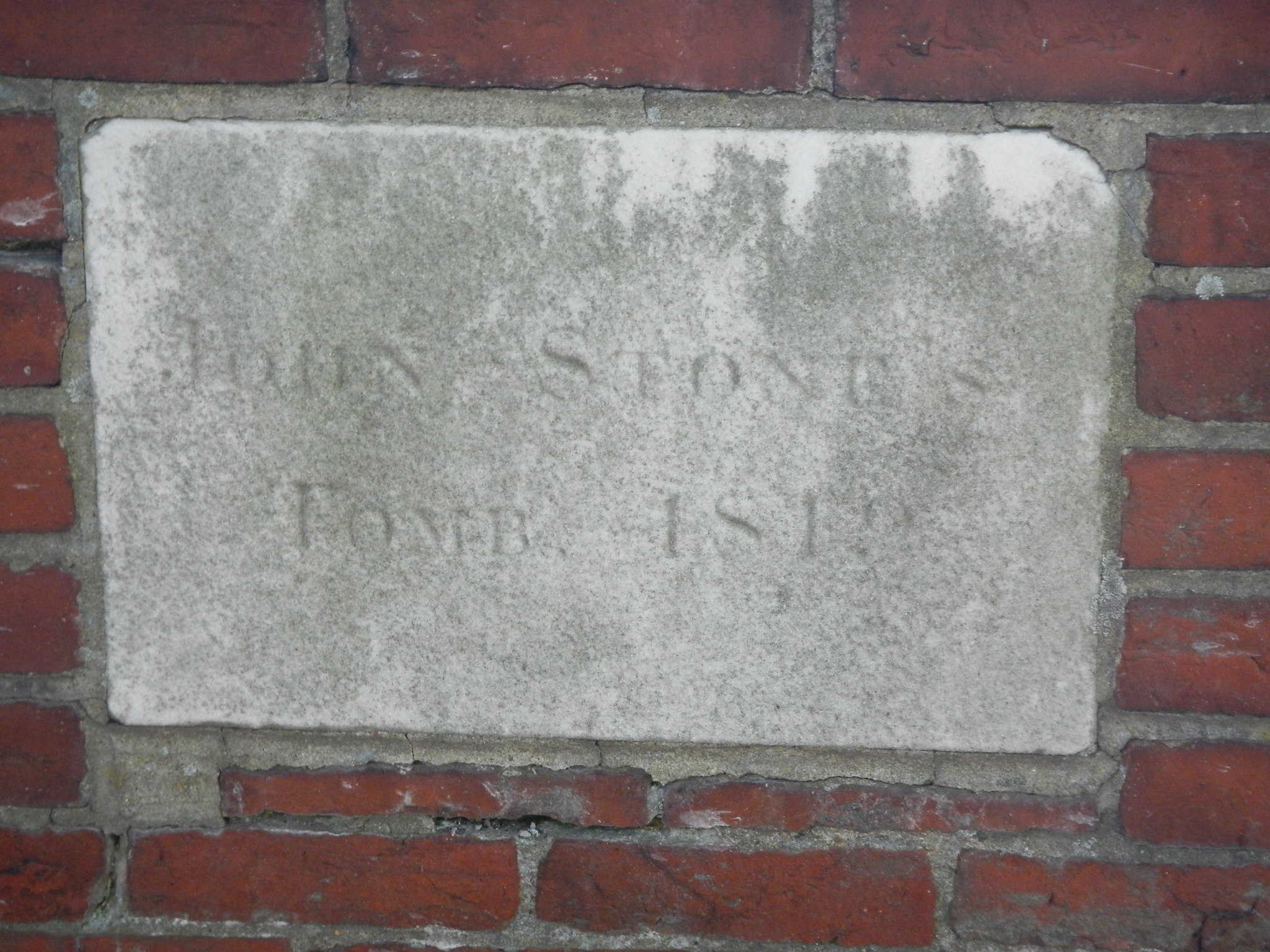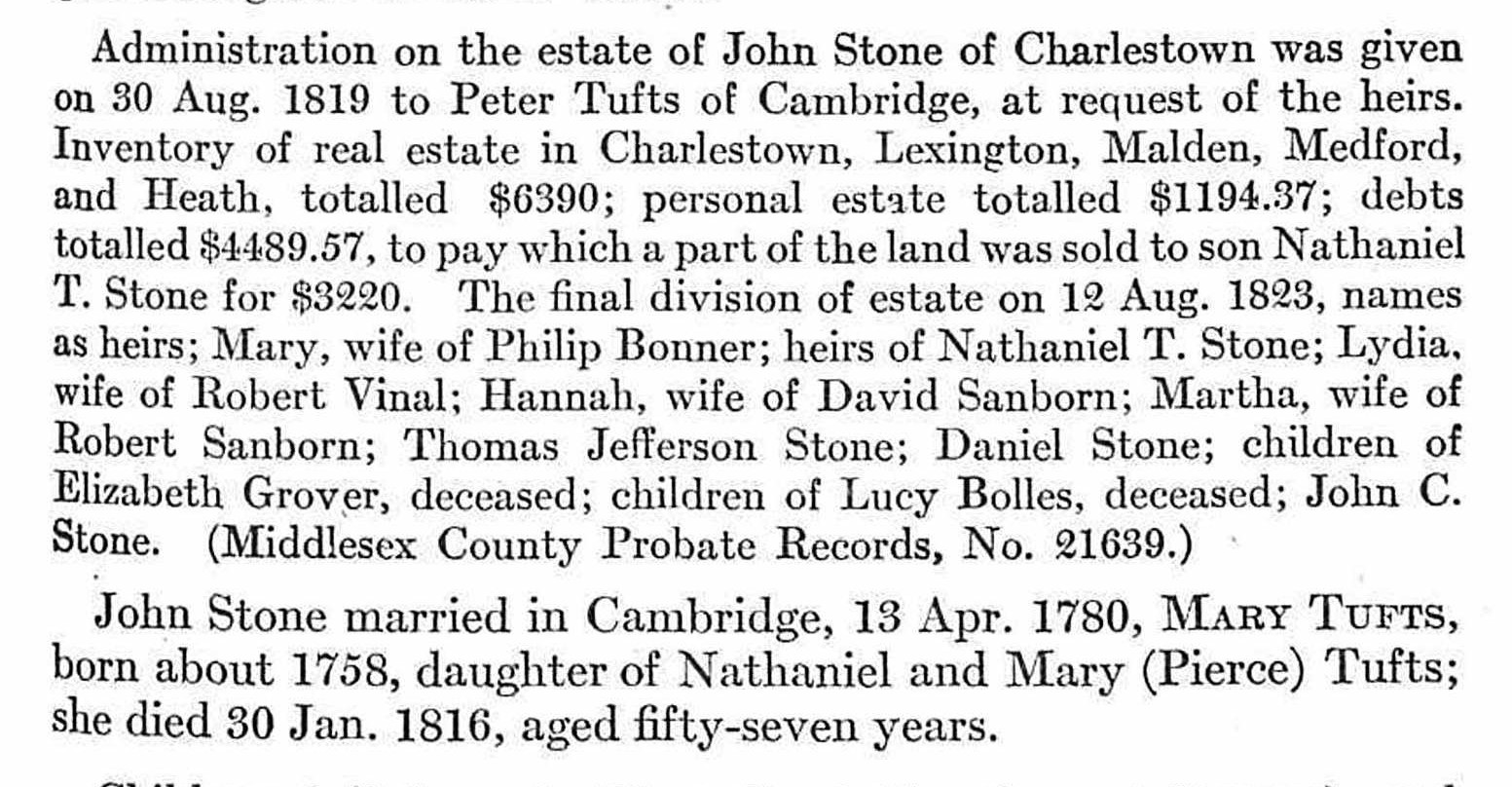He serve in Capt. Benjamin Egdell's Company and Col. John Jacobs MA Regiment.
He enlisted on July 6, 1778 with Capt. Egdell and served until Jan 1, 1779 in Col. Jacob's regiment. His service took him sixty miles from home.
Son of Jonathan & Martha (Cutter) Stone.
There are 2 births records for him, one in Shewsbury and one in Watertown. The one in Watertown is handwritten, the other is transcribed. Shewsbury shows up in DAR records for people's personal lineage.
While most of his family is resting in Cambridge, his final resting place in Charlestown is only 2.55 miles away.
"John and Mary Stone moved to the southerly side of Prospect Hill in 1782 from Cambridge. "The combined area of these lots formed a tract which extended from Vinal Ave. to and including the Prospect Hill School house lot; from the line of the Thorpe land on Walnut St., some 100 or more feet north of Boston St. and for about half the length of Columbus Avenue, along the northerly bounds of the lots on that avenue, to Bow and Washington Streets. Later, through his wife, Mary, who inherited from her father, the area was extended to School Street, as far north as Summer Street.
The situation of the house he lived in when he first came to this locality is a matter of uncertainty. An early purchase (1783) was a lot of land above Columbus Avenue, where possibly there was a house. It was not until 1793 and 1795 that he bought land on Bow Street, where was located the "home lot" mentioned in the partition of his real estate after his death, bounded southerly by "Milk Row, so called", which at that time took the course now laid out as Bow Street. At a later date he possibly lived in the old house, formerly in Union Square, which was moved before Pythian Block was built. This house moved to Medford Street, and perhaps to this day the front door bears the original knocker.
In the records of his land transactions there are three different words used to describe or designate his station or occupation. The first is “cooper”, the second “husbandman”, the third “yeoman.” Possibly these indicate the different steps of his advancement and prosperity. Probably he took some part in the affairs of the town, especially those connected with is immediate neighborhood; if he did so, it is buried in the manuscript records of Charlestown. That he was looked up to in his own family is shown by the fact that all the children called him “Sir Stone”. Whether or not this is a contraction of grand sire is a conundrum we cannot now answer.
He was associated with Timothy Tufts, Nathaniel Hawkins, Samuel Kent, Samuel Shed, and others in the purchase from Samuel Tufts of a lot of land for a cemetery in 1804. This was the well-known rectangular lot on Somerville Avenue at the foot of School Street, on one corner of which stood the school known as the Milk Row School.
There is an old Bible containing “the records of Mr. John Stone and Mrs. Mary stone’s children and the time of their births.” They were blessed with thirteen, two of whom died in infancy. (the author lists the names of the children and dates of their birth)
The title and the first four names were written at one sitting apparently, probably with a quill pen. Additions have been made by a later hand, or hands, judging by the two different inks used to complete the record, which is nearly correct. The proper dates, or, more correctly speaking, the dates of baptism have been found in the records of the First Parish, Cambridge. Comparison of dates shows that the children were baptized in from four to fifteen days after birth. It may be further noted that Mary Stone was baptized “Polly Tufts, “ that Hannah was given Adams for a middle name and John the name of Cutter. John Stone owned a pew in the First Parish Church, and in all probability attended church there. It seems safe to surmise that the children went to the Milk Row School, a description of which Mr. Hawes has given us in his paper on the schools of Charlestown.
Most of the children on their marriage settled, it might be said, within a stone’s throw of the old homestead. One lived in East Cambridge for a time, and tow or more in Boston.
John Cutter Stone, the oldest son, owned land on the southerly side of Union Square, as far down as Prospect Street. That he married and settled near is shown by the record of the baptism “ by her own desire,” of his wife, Eliza Stone, on the presentation of a child, John Tufts, for baptism December 5, 1802; another child, David was baptized in 1804.
Jonathan owned land below Prospect Street, bounded by Miller’s River. He was a house-wright, according to Wyman. It is said that he met his death by drowning in Miller’s River. He was a sleep-walker, and while being anxiously followed one night was suddenly awakened by his brother’s outcry when the latter found him up to his neck in the river. His father had just built a tomb in the old cemetery at Harvard Square, and the young man’s body was the first to be put into it. An interesting item in the life of this unfortunate young man is that the record of his birth written in the book at Cambridge is in the handwriting of old Dr. Holmes, then the minister of the church, the father of Dr. Holmes, the humorist.
Three daughters made their homes near the family roof-tree. Betsy was the first of the daughters to leave the home nest. She married Benjamin Grover November 13, 1803. In 1804 there is recorded the renewal of the covenant for the baptism of children by this couple, and their residence is given as New Bridge. Later, in 1807, the baptism of another child is recorded and they are put down as of Cambridgeport. It is evidently the same place under a new name, which still clings to it. The old custom of naming the children after the parents was followed in this case, Benjamin and Elizabeth. They moved to Concord, NH, and the present generation knows them by name only, and nothing of their descendants.
A receipt in full for the share of John Stone’s estate falling to the Grover children appears in the petition of his real estate in 1823, and is signed by an uncle, showing that Elizabeth died before her children came of age.
Mary, whose baptismal name was Polly Tufts, followed her sister Betsy in the matrimonial quickstep executed by this family with a wedding every year for four successive years. She married PHilp Bonner, of Boston, in 1804. Their marriage only is recorded in the Cambridge Parish records, as they lived in Boston for a number of years, on Spear Place off Pleasant Street. Mary Stone is put down as of Charlestown (Cambridge Parish). They sang in the choir of the Old South Church, and later at the Hollist Street Church. They came to Charlestown and lived in a house, which stood under the large elm tree in the Prospect Hill School yard. After a time it was moved a little further up the hill. Later a larger house was built still further up the hill, and here Mary Bonner died, at the age of eighty-three. The old house was moved to the neighborhood of Wyatt’s Field a few years ago. Mary Bonner had beautiful hair and dark eyes. At her death she had no gray hair. Her teeth were sound; it is said, all double".
(See the Tufts University online Perseus Library for the remainder of the article.)
_ Thank you to "bmangum411" for transcribing the later part of this Bio that is in quotations.
He serve in Capt. Benjamin Egdell's Company and Col. John Jacobs MA Regiment.
He enlisted on July 6, 1778 with Capt. Egdell and served until Jan 1, 1779 in Col. Jacob's regiment. His service took him sixty miles from home.
Son of Jonathan & Martha (Cutter) Stone.
There are 2 births records for him, one in Shewsbury and one in Watertown. The one in Watertown is handwritten, the other is transcribed. Shewsbury shows up in DAR records for people's personal lineage.
While most of his family is resting in Cambridge, his final resting place in Charlestown is only 2.55 miles away.
"John and Mary Stone moved to the southerly side of Prospect Hill in 1782 from Cambridge. "The combined area of these lots formed a tract which extended from Vinal Ave. to and including the Prospect Hill School house lot; from the line of the Thorpe land on Walnut St., some 100 or more feet north of Boston St. and for about half the length of Columbus Avenue, along the northerly bounds of the lots on that avenue, to Bow and Washington Streets. Later, through his wife, Mary, who inherited from her father, the area was extended to School Street, as far north as Summer Street.
The situation of the house he lived in when he first came to this locality is a matter of uncertainty. An early purchase (1783) was a lot of land above Columbus Avenue, where possibly there was a house. It was not until 1793 and 1795 that he bought land on Bow Street, where was located the "home lot" mentioned in the partition of his real estate after his death, bounded southerly by "Milk Row, so called", which at that time took the course now laid out as Bow Street. At a later date he possibly lived in the old house, formerly in Union Square, which was moved before Pythian Block was built. This house moved to Medford Street, and perhaps to this day the front door bears the original knocker.
In the records of his land transactions there are three different words used to describe or designate his station or occupation. The first is “cooper”, the second “husbandman”, the third “yeoman.” Possibly these indicate the different steps of his advancement and prosperity. Probably he took some part in the affairs of the town, especially those connected with is immediate neighborhood; if he did so, it is buried in the manuscript records of Charlestown. That he was looked up to in his own family is shown by the fact that all the children called him “Sir Stone”. Whether or not this is a contraction of grand sire is a conundrum we cannot now answer.
He was associated with Timothy Tufts, Nathaniel Hawkins, Samuel Kent, Samuel Shed, and others in the purchase from Samuel Tufts of a lot of land for a cemetery in 1804. This was the well-known rectangular lot on Somerville Avenue at the foot of School Street, on one corner of which stood the school known as the Milk Row School.
There is an old Bible containing “the records of Mr. John Stone and Mrs. Mary stone’s children and the time of their births.” They were blessed with thirteen, two of whom died in infancy. (the author lists the names of the children and dates of their birth)
The title and the first four names were written at one sitting apparently, probably with a quill pen. Additions have been made by a later hand, or hands, judging by the two different inks used to complete the record, which is nearly correct. The proper dates, or, more correctly speaking, the dates of baptism have been found in the records of the First Parish, Cambridge. Comparison of dates shows that the children were baptized in from four to fifteen days after birth. It may be further noted that Mary Stone was baptized “Polly Tufts, “ that Hannah was given Adams for a middle name and John the name of Cutter. John Stone owned a pew in the First Parish Church, and in all probability attended church there. It seems safe to surmise that the children went to the Milk Row School, a description of which Mr. Hawes has given us in his paper on the schools of Charlestown.
Most of the children on their marriage settled, it might be said, within a stone’s throw of the old homestead. One lived in East Cambridge for a time, and tow or more in Boston.
John Cutter Stone, the oldest son, owned land on the southerly side of Union Square, as far down as Prospect Street. That he married and settled near is shown by the record of the baptism “ by her own desire,” of his wife, Eliza Stone, on the presentation of a child, John Tufts, for baptism December 5, 1802; another child, David was baptized in 1804.
Jonathan owned land below Prospect Street, bounded by Miller’s River. He was a house-wright, according to Wyman. It is said that he met his death by drowning in Miller’s River. He was a sleep-walker, and while being anxiously followed one night was suddenly awakened by his brother’s outcry when the latter found him up to his neck in the river. His father had just built a tomb in the old cemetery at Harvard Square, and the young man’s body was the first to be put into it. An interesting item in the life of this unfortunate young man is that the record of his birth written in the book at Cambridge is in the handwriting of old Dr. Holmes, then the minister of the church, the father of Dr. Holmes, the humorist.
Three daughters made their homes near the family roof-tree. Betsy was the first of the daughters to leave the home nest. She married Benjamin Grover November 13, 1803. In 1804 there is recorded the renewal of the covenant for the baptism of children by this couple, and their residence is given as New Bridge. Later, in 1807, the baptism of another child is recorded and they are put down as of Cambridgeport. It is evidently the same place under a new name, which still clings to it. The old custom of naming the children after the parents was followed in this case, Benjamin and Elizabeth. They moved to Concord, NH, and the present generation knows them by name only, and nothing of their descendants.
A receipt in full for the share of John Stone’s estate falling to the Grover children appears in the petition of his real estate in 1823, and is signed by an uncle, showing that Elizabeth died before her children came of age.
Mary, whose baptismal name was Polly Tufts, followed her sister Betsy in the matrimonial quickstep executed by this family with a wedding every year for four successive years. She married PHilp Bonner, of Boston, in 1804. Their marriage only is recorded in the Cambridge Parish records, as they lived in Boston for a number of years, on Spear Place off Pleasant Street. Mary Stone is put down as of Charlestown (Cambridge Parish). They sang in the choir of the Old South Church, and later at the Hollist Street Church. They came to Charlestown and lived in a house, which stood under the large elm tree in the Prospect Hill School yard. After a time it was moved a little further up the hill. Later a larger house was built still further up the hill, and here Mary Bonner died, at the age of eighty-three. The old house was moved to the neighborhood of Wyatt’s Field a few years ago. Mary Bonner had beautiful hair and dark eyes. At her death she had no gray hair. Her teeth were sound; it is said, all double".
(See the Tufts University online Perseus Library for the remainder of the article.)
_ Thank you to "bmangum411" for transcribing the later part of this Bio that is in quotations.
Family Members
Advertisement
Explore more
Sponsored by Ancestry
Advertisement












